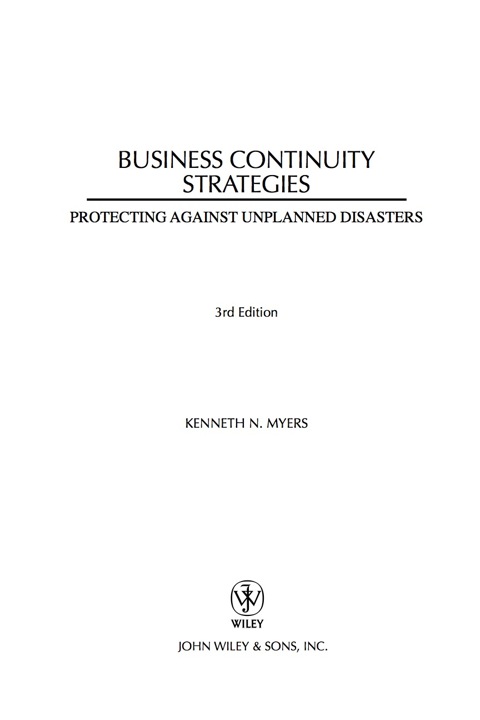Description
Efnisyfirlit
- BUSINESS CONTINUITY STRATEGIES: PROTECTING AGAINST UNPLANNED DISASTERS
- CONTENTS
- PREFACE
- Chapter 1: Defining the Problem
- BUSINESS CONTINUITY CONCERNS
- Telephone Communications
- Computer Processing
- Vital Facilities
- Only a Computer Recovery Plan
- Current Program May Not Work
- CHARACTERISTICS OF A SOUND PROGRAM
- COST-REDUCTION OPPORTUNITIES
- How to Contain Program Development Costs
- Where to Look for Cost Reductions in an Existing Computer Disaster Recovery Plan
- Audit Concerns
- Involving Department Managers
- NEED FOR COST-EFFECTIVE SOLUTIONS
- BACKUP
- Chapter 2: Workplace Violence
- BACKGROUND
- What Is Workplace Violence?
- Who Is Vulnerable?
- Contributing Factors
- LIABILITY
- Employer Liability
- Security
- Workplace Violence Incidents
- Three Stages Prior to Workplace Violence
- PREVENTION
- Policy and Strategy
- Workplace Violence and Boards of Directors
- Reducing Exposure to Workplace Violence
- What Can Employers Do to Protect Employees?
- How Can Employees Protect Themselves?
- Warning Signs of Violence
- Performance Indicators
- Employee Training
- Supervisory Training
- Alternate Dispute Resolution
- Incident Response Team Training
- INCIDENT RESPONSE
- Critical Incident Stress Debriefing
- Recommendation
- Chapter 3: Final Reports of the Federal Building and Fire Investigation of the World Trade Center Di
- INTRODUCTION
- Genesis of This Investigation
- November 29, 2005 Report Recommendations
- INCREASED STRUCTURAL INTEGRITY
- Recommendation 1
- Recommendation 2
- Recommendation 3
- ENHANCED FIRE ENDURANCE OF STRUCTURES
- Recommendation 4
- Recommendation 5
- Recommendation 6
- Recommendation 7
- NEW METHODS FOR FIRE-RESISTANT DESIGN OF STRUCTURES
- Recommendation 8
- Recommendation 9
- Recommendation 10
- Recommendation 11
- IMPROVED ACTIVE FIRE PROTECTION
- Recommendation 12
- Recommendation 13
- Recommendation 14
- Recommendation 15
- IMPROVED BUILDING EVACUATION
- Recommendation 16
- Recommendation 17
- Recommendation 18
- Recommendation 19
- Recommendation 20
- IMPROVED EMERGENCY RESPONSE
- Recommendation 21
- Recommendation 22
- Recommendation 23
- Recommendation 24
- IMPROVED PROCEDURES AND PRACTICES
- Recommendation 25
- Recommendation 26
- Recommendation 27
- Recommendation 28
- EDUCATION AND TRAINING
- Recommendation 29
- Recommendation 30
- LOOKING FORWARD
- Chapter 4: New Contingency Program Paradigm
- BACKGROUND
- Strategies versus Plans
- Terrorist Incidents
- Terrorism, Workplace Violence, and Boards of Directors
- OLD PARADIGM
- Organizational Responsibility
- Foreign Corrupt Practices Act
- Common Mistakes
- Computer Oriented
- Systemic Problems
- NEW PARADIGM
- Mind-Set
- Organizational Responsibility
- Terrorism
- Facility Oriented
- Workplace Violence
- Contingency Program Components
- TRANSITIONING TO THE NEW PARADIGM
- Organizational Responsibility
- Policy and Strategy
- Development of Interim Processing Strategies
- Chapter 5: Developing a Contingency Program
- MANAGEMENT’S RESPONSIBILITY
- HOW MUCH MARKET SHARE COULD COST YOU?
- PROTECT AGAINST WHAT?
- CONTINGENCY PLANNING REQUIRES SPECIALIZATION
- INCREASED TECHNOLOGY DEPENDENCY
- CORPORATE ISSUE
- CONTINGENCY PROGRAM PHASES
- Prevention
- Incident Recovery
- Interim Processing
- DISCRETIONARY EXPENSE
- PROJECT PLANNING
- Policy and Strategy
- Limit Scope
- Limit the Time Periods
- Surgical Process
- Game Plan
- Team Concept
- Prototype Programs
- AWARENESS AND EDUCATION
- Business and Environment
- Types of Disasters
- Potential Impact on Business
- Program Objectives
- Insurance Considerations
- How Much Detail?
- Establishing a Firm Foundation
- Key Result Areas
- Convincing Others
- Executive Briefings
- BUSINESS IMPACT ANALYSIS
- Objective
- What Is Really Critical?
- Awareness and Education
- Regulatory Agency Reporting Requirements
- Window
- SELECTING A METHODOLOGY
- Philosophy
- Setting the Stage for Success
- Program Requirements
- Program Development Steps
- Key Tasks
- Developing “What If” Interim Processing Strategies
- Computer Processing Alternatives
- Documentation
- Cost Benefits
- Corporate Benefits
- IMPLEMENTATION
- Tailor Presentations
- Role of Senior Management
- Role of a Steering Committee
- Role of Department Managers
- Role of First-Line Supervisors
- Role of Outside Specialists
- Develop Program with First-Line Supervisors
- Obtain Department Managers’ Approval
- Noncomputerized Business Functions
- MAINTENANCE AND TESTING
- Objectives
- Maintenance
- Continuing Education and Preparedness Reviews
- Technology Testing
- Chapter 6: Guidelines for Developing Contingency Programs at Multiple
- BACKGROUND
- OBJECTIVES AND SCOPE
- SECTION I: ORGANIZATION
- Placement of the Contingency Planning Activity
- Organizational Functions
- SECTION II: STANDARDS FOR IMPLEMENTATION PLANNING
- Methods Standards
- Performance Standards
- SECTION III: STANDARDS FOR DEVELOPING INTERIM PROCESSING STRATEGIES
- Methods Standards
- Performance Standards
- SECTION IV: DOCUMENTATION STANDARDS
- Methods Standards
- Performance Standards
- SECTION V: STANDARDS FOR ONGOING MAINTENANCE AND TESTING
- Methods Standards
- Performance Standards
- Chapter 7: Conceptual Business Continuity Strategies for Loss of Computer Operations
- POLICY AND STRATEGY
- Policy
- Strategy
- EXECUTIVE SUMMARY
- Normal Operations
- Emergency Response
- Interim Processing
- Maintenance and User Continuing Education and Preparedness Reviews
- GLOSSARY
- INDEX







Reviews
There are no reviews yet.